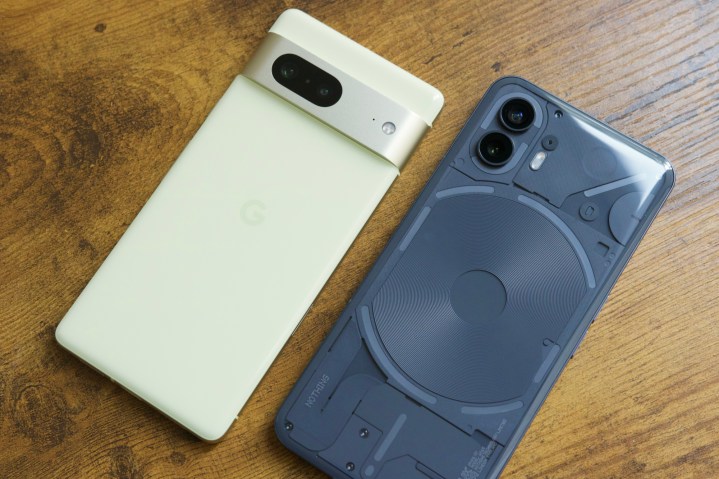
The upstart company Nothing created quite a stir when it came on the scene a little over two years ago, with OnePlus co-founder Carl Pei promising to shake up the mobile phone industry in the same way his former company did in its fledgling days. While Nothing started small with the Ear 1 earbuds, it quickly followed that up with the Nothing Phone 1 — a new Android handset that was like nothing we’d seen before (no pun intended).
Now, it’s released its second act, the Nothing Phone 2, a $600 smartphone that impresses in nearly every way. It’s an exciting new phone in an era where the alternatives have become considerably more staid — and that’s even more true in the U.S.
The big question now is whether the Nothing Phone 2 has what it takes to unseat the Google Pixel 7 from its perch among the reigning smartphone champs. Let’s dig in and see how the two stack up side by side.
Nothing Phone 2 vs. Google Pixel 7: specs
| Nothing Phone 2 | Google Pixel 7 | |
| Size | 162.1 x 76.4 x 8.6 mm (6.38 x 3 x 0.33 inches) | 155.6 by 73.2 by 8.7mm (6.13 by 2.88 by 0.34 inches) |
| Weight | 201.2 grams (7.09 ounces) | 197 grams (6.9 ounces) |
| Screen size | 6.7-inch OLED | 6.3-inch AMOLED |
| Screen resolution | 2412 x 1080 pixels (394 pixels per inch), 120Hz refresh rate | 2400 x 1080 pixels (416 pixels per inch), 90Hz refresh rate |
| Operating system | Nothing OS 2.0 (based on Android 13) | Android 13 |
| Storage | 128GB, 256GB, 512GB | 128GB, 256GB |
| MicroSD card slot | No | No |
| Processor | Qualcomm Snapdragon 8+ Gen 1 | Google Tensor Gen 2 |
| RAM | 8GB, 12GB | 8GB |
| Camera | 50MP main camera, 50MP ultrawide camera, 32MP selfie camera | 50MP main camera, 12MP ultrawide camera, 10.8MP front camera |
| Video | Up to 4K at 60 frames per second (fps) | 4K at up to 60 frames per second (fps), 1080p at 60 fps |
| Bluetooth version | Bluetooth 5.3 | Bluetooth 5.2 |
| Ports | USB-C | USB-C |
| Fingerprint sensor | Yes, in-display | Yes, in-display |
| Water resistance | IP54 | IP68 |
| Battery | 4,700mAh
45W wired charging 15W wireless charging 5W reverse charging |
4,355mAh
30W wired charging 21W wireless charging Reverse wireless charging |
| App marketplace | Google Play Store | Google Play Store |
| Network support | AT&T, T-Mobile | Most major carriers |
| Colors |
Dark gray, white |
Obsidian, Snow, Lemongrass |
| Price | Starting at $599 | Starting at $599 |
| Buy from | Nothing | |
| Review | Nothing Phone 2 review | Google Pixel 7 review |
Nothing Phone 2 vs. Google Pixel 7: design and display
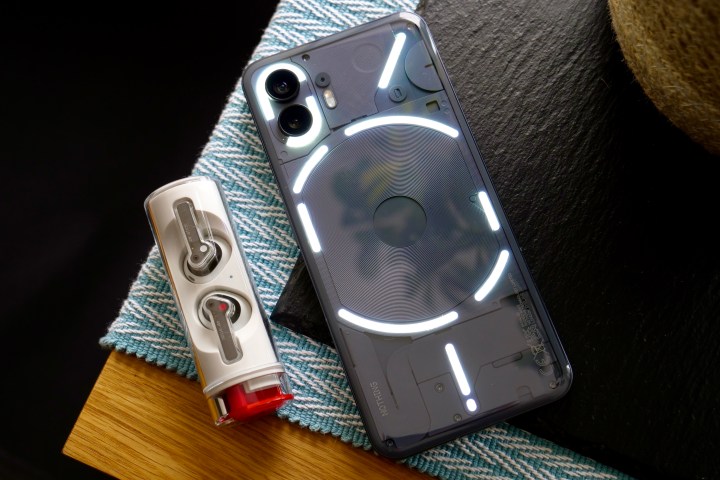
Like its predecessor, the Nothing Phone 2 sports a design that’s absolutely unique and most definitely opinionated. While the style isn’t for everyone, it’s meticulously crafted with a well-thought-out design, from the overall build quality to the transparent back and Glyph lights.
There’s impressive attention to detail here, and the Nothing Phone 2 makes a statement in a way that we rarely see among modern smartphones. At 8.6mm thick with a 6.7-inch screen, it weighs in at a hefty 201 grams, yet it manages to feel solid without being hefty.
In contrast, Google’s Pixel 7 seems downright conservative in its design, which is somewhat ironic considering the horizontal camera bar was considered unique and a bit risqué in its own way when Google first introduced it on the Google Pixel 6. It’s great that Google embraces its camera bumps rather than trying to pretend they’re not there, but Nothing takes it a big step further by forging the entire smartphone design into something that looks like a futuristic museum piece.
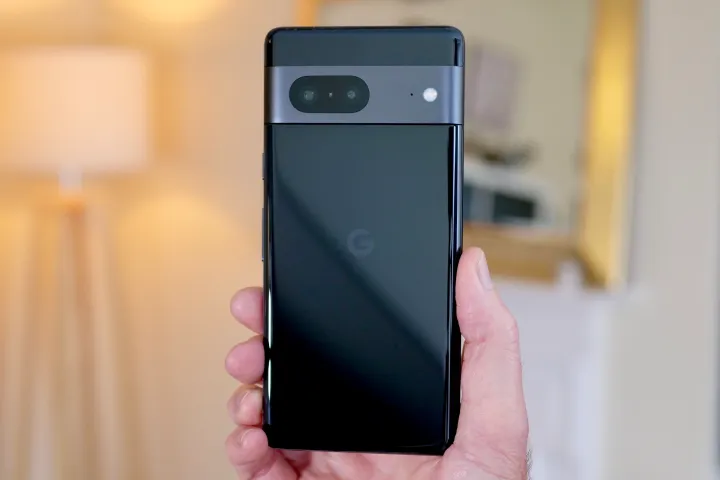
At 8.7mm thick and 197 grams, the Pixel 7 comes in at around the same girth and weight as the Nothing Phone 2, although the 6.3-inch Pixel 7 is smaller in length and width, which makes it feel heavier in the hand. Both phones use a slippery glass back, so you’ll likely want to slap a case on them, but that’s kind of unfortunate with the Nothing Phone 2, which all but screams for a caseless presentation. We imagine there’s going to be a big market for transparent cases for the Nothing Phone 2.
The biggest knock against the Nothing Phone 2 is that it only features an IP54 certification for dust and water resistance, compared to the Pixel 7’s more typical IP68. The IP54 rating is far more common among headphones than smartphones, and while it means you won’t need to worry about taking the Nothing Phone 2 out in the rain, it’s less likely to survive a dip in the pool.

Although the Nothing Phone 2 looks fantastic around the back, when you flip it around to the front screen, it’s more on par with other smartphones in its class. It edges out the Google Pixel 7 by offering a dynamic refresh rate that can run from 1Hz all the way up to 120Hz. The Pixel 7 only goes to 90Hz, a respectable refresh rate, but something that’s kind of table stakes for upper-midrange smartphones now. Both phones boast virtually identical resolutions, which means the Pixel 7 gets a slightly higher pixel density of 416 pixels per inch (ppi) versus 394 ppi for the Nothing Phone 2, but that’s not a difference anyone will notice with the naked eye.
Other than the size and refresh rate differences, the OLED screens are comparable in nearly every other way, with 1,000 nits of outdoor brightness and rich and saturated colors. The Nothing Phone 2 promises up to 1,600 nits of peak brightness for HDR playback, whereas Google only claims 1,400 for the Pixel 7, but this isn’t something most folks are likely to be too concerned about.
With a more unique design and a more technically capable display, it’s the Nothing Phone 2 that wins the first round.
Winner: Nothing Phone 2
Nothing Phone 2 vs. Google Pixel 7: performance and battery
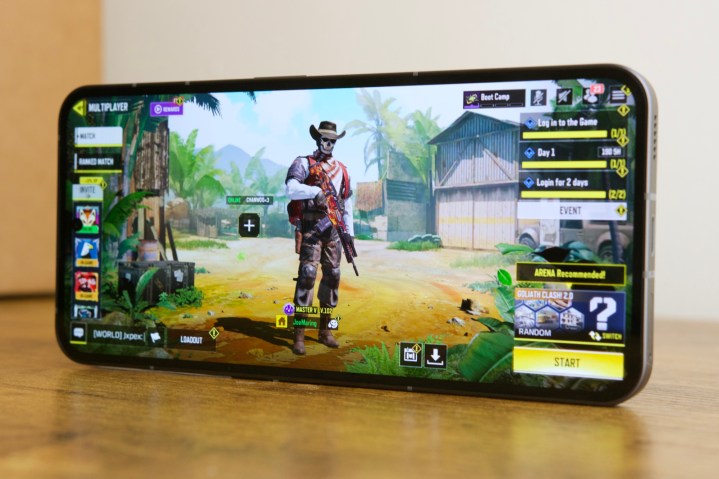
The Nothing Phone 2 packs in Qualcomm’s Snapdragon 8+ Gen 1. That’s the same chip used in last year’s Galaxy Z Fold 4, Galaxy Z Flip 4, and OnePlus 10T, which may lead you to believe that Nothing is behind the curve with this one, but our experience suggests that nothing could be further from the truth.
After all, we’re well past the point where raw performance makes much difference in your day-to-day tasks. These days, the push toward faster chips is primarily about leaving enough headroom to power more advanced machine learning features like computational photography. The Snapdragon 8+ Gen 1 is certainly no slouch, and Nothing isn’t even trying to mirror the advanced photography features of its rivals, which means that the Nothing Phone 2 has plenty of power to spare.
If anything, the Pixel 7 is an example of the opposite extreme, as it uses Google’s own Tensor G2 chip that’s arguably more about neural engine processing than performance. In pure specs, it lags behind the Snapdragon 8+ Gen 1, but as a custom chip, it’s allowed Google to bake in some impressive optimizations to deliver a smooth user experience equal to just about any phone on the market in terms of everyday performance.
The Nothing Phone 2 and Google Pixel 7 should perform equally well in daily use, and while neither is what we’d call a gaming phone, they’re both capable enough for casual gamers. However, the Nothing Phone 2 pulls ahead in this area thanks to its 120Hz screen and Snapdragon 8+ Gen 1 chip, which make it suitable for more demanding games.

The Nothing Phone 2 and Google Pixel 7 have 4,700 mAh and 4,355 mAh batteries, respectively, yet both manage to deliver good battery life thanks to optimizations in their respective processors and other hardware.
The Snapdragon 8+ Gen 1 is one of the most power-efficient processors in its performance class, and the Nothing Phone 2 takes advantage of that to deliver more than all-day battery life. In fact, unless you’re doing a lot of gaming, you’ll more likely get about a day and a half before the Nothing Phone 2 needs to hit a charger.
Despite its smaller cell, the Pixel 7 delivers similar battery life for everyday use, thanks to the power efficiency of Google’s Tensor G2 chip. You’ll easily get through a full day on a single charge unless you use it for gaming, which is where the Pixel 7 lags most seriously. As we discovered in our review, with high-performance games like Asphalt 9, you can lose up to 10% of your battery after only 15 minutes of play.
That’s also significant when you consider that the Google Pixel 7 isn’t the fastest-charging smartphone out there. You get the standard 20-watt USB Power Delivery spec that can top it up to 50% in 30 minutes and to a full charge in about two hours. That’s on par with Apple’s iPhone lineup, but falls well short of the 45W charging speeds the Nothing Phone 2 offers, which can get the larger battery topped up in just under an hour.
It’s another win for the Nothing Phone 2 here.
Winner: Nothing Phone 2
Nothing Phone 2 vs. Google Pixel 7: cameras
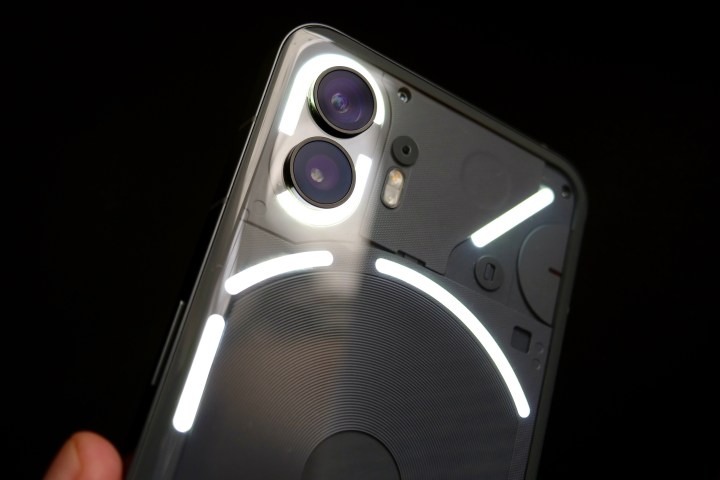
The Nothing Phone 2 sports a pair of 50-megapixel (MP) shooters in the typical wide and ultrawide configurations, plus a 32MP selfie camera around the front. That’s better on paper than the 50MP and 12MP duo found on the Pixel 7 and a considerable improvement over Google’s 10.8MP front camera.
However, as with most smartphones in this class, it’s the software that makes the difference. Google has consistently led in this area, but the Nothing Phone 2 still manages to hold its own under the right lighting conditions, producing photos that are more natural and colorful without being oversaturated.

Nevertheless, the Google Pixel 7 arguably takes better photos with more punchiness and brilliance, and it does so in just about any lighting conditions. Google practically invented modern computational night mode photography with its Pixel lineup, and few other smartphones can match its lowlight photographic performance.
Sadly, the Nothing Phone 2 doesn’t even try in this area. Under lower lighting conditions, image quality falls off a cliff, losing detail and collecting more noise. This makes the difference between the Nothing Phone 2 and Google Pixel 7 quite literally a night-and-day comparison.
If taking the best possible photos is a priority, the Google Pixel 7 runs circles around the Nothing Phone 2 unless you only plan to take photos in typical daytime lighting. However, the Pixel 7 also gets the edge even here due to the more extensive collection of AI features that can be used to enhance your images, both during shooting and after the fact.
The Nothing Phone 2 puts up a good fight, but the Pixel 7 easily wins this round.
Winner: Google Pixel 7
Nothing Phone 2 vs. Google Pixel 7: software and updates

The Nothing Phone 2 ships with Android 13 with the company’s Nothing OS 2.0 interface layered on top, which offers a fascinating monochromatic look that complements the phone’s overall design. It’s indisputably unique and fits quite nicely with the Nothing brand, but it’s also pretty dull to look at. For those who don’t see the appeal, Nothing lets you switch back to the familiar and much more colorful Android theme.
That will deliver a look similar to most Android 13 smartphones, although Nothing has added a few useful twists without creating the overbearing software experience that others have morphed into. Nothing has taken a remarkably light touch with Nothing OS 2.0.
However, Google’s Pixel 7 offers about as pure of an Android user experience as you can get, plus tighter integration into the overall Google experience. The Pixel 7 still has several unique software features, particularly in areas like photo editing and AI tools, but these don’t impact the clean user interface design.
When it comes to major software updates, the Nothing Phone 2 and Google Pixel 7 are basically on par. Google promises major Android updates through October 2025, which should take the Pixel 7 to Android 16, while the Nothing Phone 2 will get the same thanks to the company’s promise of three major Android version updates.
Similarly, Nothing promises four years of security patches, while Google says the Pixel 7 is guaranteed security updates until October 2027.
Winner: Tie
Nothing Phone 2 vs. Google Pixel 7: special features

The one thing that really sets Nothing’s smartphones apart is their Glyph lights, and the Nothing Phone 2 takes this feature to an even more useful level. While the lights are a bit gimmicky, they’re also a fun way to communicate a lot of information to the user, and they also act as fill lights for the cameras.
For instance, the Glyph bars can act as visual timers to show you when your dinner is ready — whether that’s because it’s finished cooking or it’s about to show up via Uber Eats. They can also flash when calls come in, show priority notifications, and stay illuminated when there’s an important message waiting. They also light up to show charging progress when the phone is facedown and plugged in.
Google’s Pixel 7 isn’t without its own unique twists, but they’re certainly less visually inspiring than what Nothing has cooked up. Mostly, it’s about using the custom Tensor G2 silicon to power photo and video capturing and editing capabilities that allow you to unblur photos, take guided selfies, and enhance the quality of your phone calls.
These features on the Pixel 7 are useful, but when it comes to truly “special” features, the Nothing Phone 2 edges it out.
Winner: Nothing Phone 2
Nothing Phone 2 vs. Google Pixel 7: price and availability
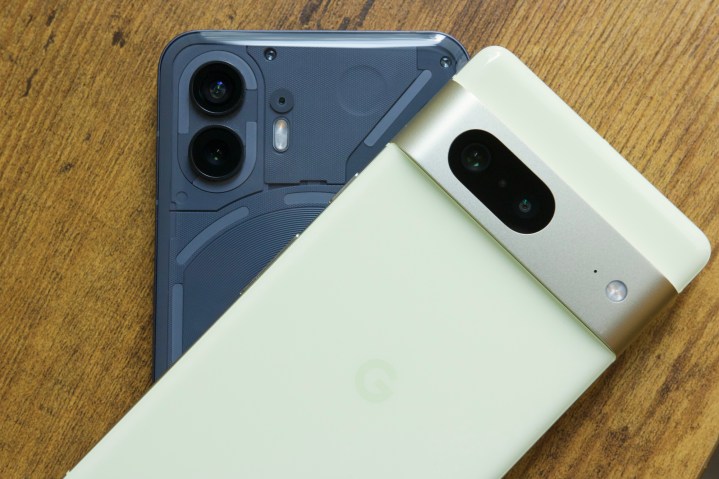
The Nothing Phone 2 is available for preorder in the U.S. and Canada via Nothing’s website in white and dark gray versions, starting at $599 for the base model with 128GB of storage and 8GB of RAM. Capacities of 256GB and 512GB are also available, with each featuring 12GB of RAM, for $699 and $799, respectively.
Google’s Pixel 7 comes at the same price of $599 for the 128GB model or $699 for the 256GB version. It’s available in Obsidian, Lemongrass, and Snow.
Overall winner: Nothing Phone 2

Although the design of the Nothing Phone 2 won’t be everyone’s cup of tea, you can’t argue that it’s a unique smartphone that stands out well from the rest of the pack. However, it’s also far much more than that, packing in one of the best Qualcomm chips we’ve seen in recent years to give it more than ample performance to handle even the most demanding games.
Combine that with three years of Android updates and excellent battery life, and the Nothing Phone 2 is easily one of the top phones to buy in its class, delivering solid bang for your buck in almost every area.
Sadly, one thing that holds the Nothing Phone 2 back is its lowlight photography capabilities. It takes very impressive pictures in daylight, but not so much at night. While there’s a chance Nothing could address this in a future software update, for now, the Google Pixel 7 still dominates the field when it comes tp smartphone photography. However, the Nothing Phone 2 comes out on top in every other important area — making it our overall winner of this comparison battle.
Editors’ Recommendations
